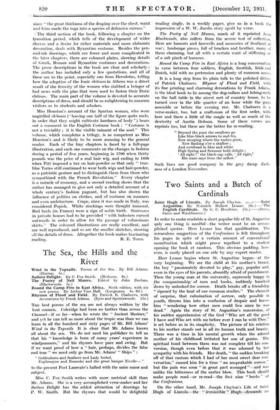Two Books on Costume
Ancient Greek, Roman and Byzantine Costume. By Mary G. Houston. (Black. 10s. 6d.)
WE have here two books likely to be of particular interest to art students, theatrical producers and the organizers of pageants. The first of them is also the second volume of A Technical History of Costume. A very important feature of the book is its illustrations, many of which are reproduced sketches of vase paintings in museums. There are also some supplementary diagrams, drawn to scale, and showing the exact methods of cutting and folding such garments as the Doric and Ionic chitones and all their variations ; the pleating of the himatia, or cloaks ; and the arrangement of the cords used to keep the garments in place. In the second section there are sketches of the T-shaped tunics, the hoods and the togas. Siveral pages describe the elaborate draping of the last-named garment, and it is interesting to learn .that the phrase, " armed with-the toga' *his historic exactitude
since the great thickness of the draping over the chest, waist and loins made the toga into a species of defensive cuirass."
The third section of the book, following a chapter on the transition period, which tells of the development of wider sleeves and a desire for richer materials and more elaborate decoration, deals with Byzantine costume. Besides the pen- and-ink drawings, which are fewer and more complicated in the later chapters, there are coloured plates, showing details of Greek, Roman and Byzantine costumes and decorations. The prose descriptions in the book are clear and scholarly : the author has included only a *few quotations, and all of
these arc to the point, especially one from Herodotus, telling how the adoption of the Ionic chitones in Athens was a direct
result of the ferocity of the women who stabbed a bringer of bad news with the pins that were used to fasten their Doric chitons. The main part of the volume is devoted to accurate descriptions of dress, and should be as enlightening to museum visitors as to students and scholars.
Miss Houston's account of the Spartan women, who wore ungirdled chitones ("leaving one half of the figure quite nude, in order that they might cultivate hardness of body ") bears out a comment in the English Costume book : " Costume is not a triviality ; it is the visible raiment of the soul." This volume, which completes a trilogy, is as competent as Miss Houston's and is likely to be more amusing to the general reader. Each of the tiny chapters is faced by a full-page illustration, and each one comments on the changes in fashion during a period of five years, beginning in 1700 when thirty pounds was the price of a real hair wig, and ending in 1800 when Pitt imposed a tax on hair-powder so that only " true- blue Tories still continued to wear both wigs and hair-powder, as a patriotic gesture and to distinguish them from those who sympathized with the French Revolution." Every chapter is a miracle of economy, and a second reading shows that the author has managed to give not only a detailed account of a whole century's fashion pageant, but has also shown the influence of politics on clothes, and of costume on manners and even architecture. Crape, since it was made in Italy, was considered Popish. White stockings were thought immoral. Red heels (in France) were a sign of noble birth. Staircases in private houses had to be provided with balusters curved outwards in order to allow for the passage of voluminous skirts." The coloured illustrations are really excellent, and are well reproduced, and so are the smaller sketches, showing all the details of dress. Altogether the book makes fascinating











































 Previous page
Previous page